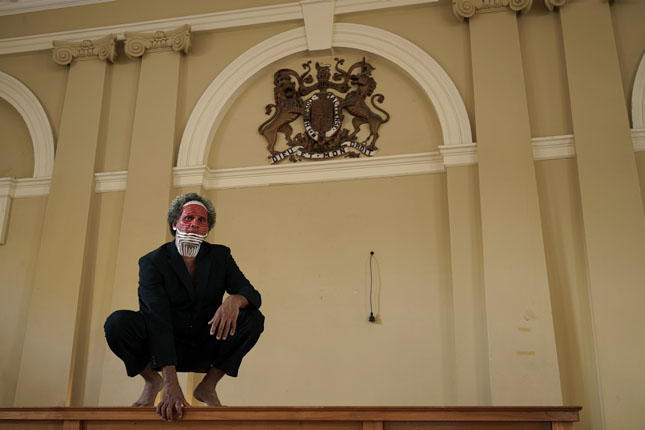
Justicia
photomedia exhibition
Bonemap created performative and photographic works during the transition of the historic Court House in Cairns. The resulting large format photographic and moving image works offer audiences a sense of the building as it was immediately prior to restoration. The artists’ intention was to explore shared social and cultural histories through the intrinsic iconography associated with the site.
Since antiquity, many historical civilisations have used visual representations symbolising the act of arbitration. Surviving examples include those from Mesopotamia circa 2350 BCE and ancient Egypt circa 1300 BCE. Likewise, the 'scales of justice' are a visual metaphor that survives as a symbol signifying the judicial system in a modern democracy. The Virtue personified as 'Lady Justice' originates in justice iconography that derives from representations of the goddess Themis in ancient Greek mythology. In Roman times Justice (Latin: Iustitia), like other Virtues, was portrayed as a young female figure. Justice holds a prominent sword and scales in the form of a beam balance. During the European Renaissance in the fifteenth century, Justice appeared blindfolded. This feature of the iconography represents impartiality in matters of state judicial arbitration. The concept that all are equal in the eyes of the law is a cornerstone of modern democracy, and the blindfold represents equality through unbiased judgement. These traits signal the weighing of facts and cutting to the truth irrespective of position or social standing. The allegory of Lady Justice derives from origin stories and philosophical ideals rooted in a moral compass.
In mythological antiquity, philosophers and believers described attributes of the Cardinal Virtues: Justice, Prudence, Fortitude and Temperance (virtues and vices). Commonly these took a female form reflecting their provenance in Egyptian, Greek and Roman goddesses. Christian iconography appropriated the personification of Justice. Representations of Saint Michael see him depicted with sword and scales, weighing souls at the Last Judgement. The Egyptian Book of the Dead describes truth and Justice in the hands of the goddess Maat, personified as a set of scales and a feather. Maat presides over an ancient funerary custom that weighs the human heart against an ostrich feather to determine safe passage to the paradise afterlife.
A mix of theological and political ideals, the Lady Justice figure, with her unbiased pre-democratic symbolism, is an emblem and theme for modern government. The Court House Gallery houses its own Lady Justice, a remnant of unknown provenance, representing historical origins and partial inspiration for Bonemap's Justicia exhibition.
Virtue's personification of Justicia romanticises the ideals of equal handed arbitration. It, in contrast, hides more harrowing stories identified with courthouse buildings. However, using the contemporary intervention of artistic practice, the juxtaposition of Indigenous identity against the symbolic backdrop of colonial power raises questions of equality and representation in the architecture of such places.
Bonemap have documented other sites in transition including Brisbane Powerhouse, The Substation (Singapore), and Tanks Arts Centre in 1993.
Russell Milledge 2021
artists:
Bonemap - Russell Milledge and Rebecca Youdell
Zane Saunders
The Court House Gallery
20 Feb – 27 March 2021
sponsors:
Cairns Regional Council
Video documentation:

